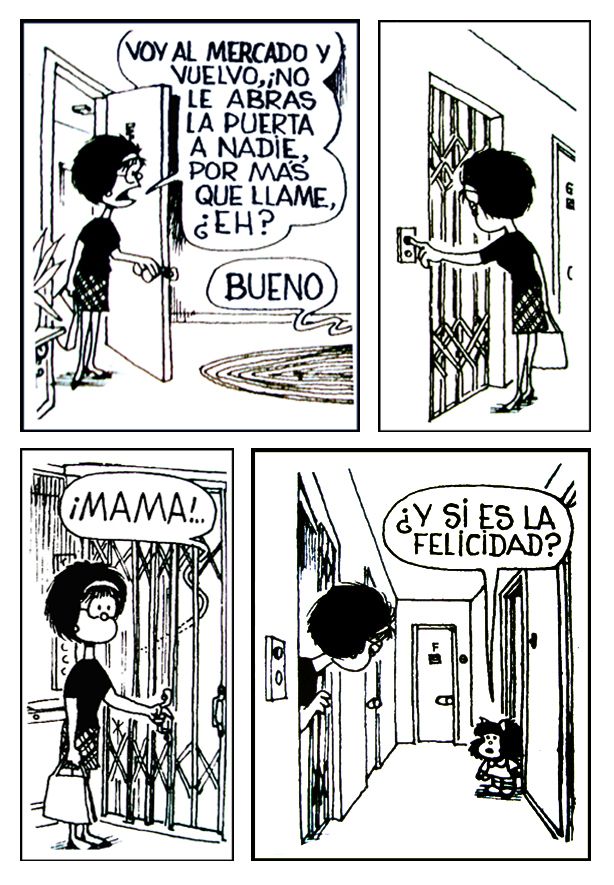Mafalda, l’enfant terrible Posted by Magda on Sep 14, 2010 in Spanish Culture
She’s a girl. She’s six years old. She loves the Beatles, pancakes, democracy, and human rights… and she hates soup. Does this sound familiar to you? No? Maybe it will, if I give you just a single name: Mafalda.
The character of Mafalda, her family and friends, were created in 1962 by Joaquin Salvador Lavado, also known as Quino. They were intended to support an advertisement campaign for an electrical household appliance company and their new product line. The company wanted to portray a typical family using their products, but the campaign was cancelled, and Mafalda drawings were forgotten for some months. In 1963 Quino started publishing his strips weekly in the Argentinean newspaper “Primera Plana”. After several months, Mafalda became a daily cartoon.
Mafalda and her parents were the first characters depicted: She is an inquisitive little girl, with a strong political view of the world and very concerned about peace and humankind. Although she’s only six, she’s quite mature for her age; she questions everything, but gets no answers that satisfy her particular logic. She hates James Bond, war, weapons, and the most awful thing in the world: soup. When she is disappointed, or desolate, she defines the world as “soup”. Nevertheless, she keeps trying to make it a better place even using her mum’s make-up. Mafalda’s parents are a normal couple, dealing with this vocal yet sympathetic girl.
Felipe was her first friend, appearing in 1965. He is a dreamer who loves playing cowboys, and has a deep sense of responsibility. His most characteristic features are his hair and his teeth.  Manolito, son of a shopkeeper, is mostly concerned about money. He seems to be simple minded, but surprises us with his insights into the world of business. Susanita is the opposite of Mafalda: a frivolous girl, her main dreams are to marry and become a mother and a housewife. Miguelito, the rebel and philosopher, and Guille, Mafalda’s little brother complete the character lineup. Through each and every one of them, the author voices his own criticism about the modern world. He makes us see, through the innocent eyes of a little girl, how everything we thought about the adult world is far from the perfect dream we had when we were children. Mafalda has left us a legacy of candid and socially aware statements, such as: “Could it be that this modern life is being more modern than life?; The world is sick, its Asia hurts; Could it be that in this world there are increasingly more people, and less individuals?”
Manolito, son of a shopkeeper, is mostly concerned about money. He seems to be simple minded, but surprises us with his insights into the world of business. Susanita is the opposite of Mafalda: a frivolous girl, her main dreams are to marry and become a mother and a housewife. Miguelito, the rebel and philosopher, and Guille, Mafalda’s little brother complete the character lineup. Through each and every one of them, the author voices his own criticism about the modern world. He makes us see, through the innocent eyes of a little girl, how everything we thought about the adult world is far from the perfect dream we had when we were children. Mafalda has left us a legacy of candid and socially aware statements, such as: “Could it be that this modern life is being more modern than life?; The world is sick, its Asia hurts; Could it be that in this world there are increasingly more people, and less individuals?”
Quino ceased publishing in 1973, but Mafalda’s success didn’t end then. Her adventures had been translated into several languages, including Chinese; there have been adaptations for cinema and theatre, series of animated shorts, and also a full length movie. Mafalda was, is, and will be a rebel forever!

Build vocabulary, practice pronunciation, and more with Transparent Language Online. Available anytime, anywhere, on any device.




